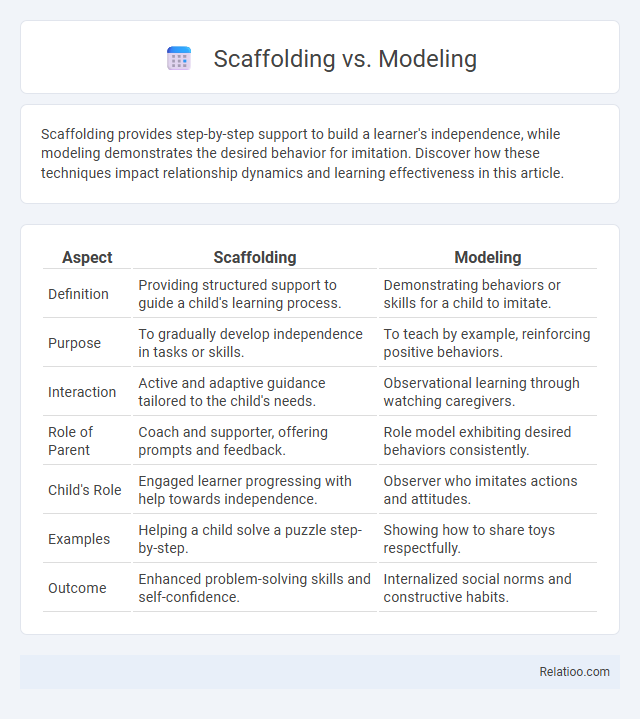Scaffolding provides step-by-step support to build a learner's independence, while modeling demonstrates the desired behavior for imitation. Discover how these techniques impact relationship dynamics and learning effectiveness in this article.
Table of Comparison
| Aspect | Scaffolding | Modeling |
|---|---|---|
| Definition | Providing structured support to guide a child's learning process. | Demonstrating behaviors or skills for a child to imitate. |
| Purpose | To gradually develop independence in tasks or skills. | To teach by example, reinforcing positive behaviors. |
| Interaction | Active and adaptive guidance tailored to the child's needs. | Observational learning through watching caregivers. |
| Role of Parent | Coach and supporter, offering prompts and feedback. | Role model exhibiting desired behaviors consistently. |
| Child's Role | Engaged learner progressing with help towards independence. | Observer who imitates actions and attitudes. |
| Examples | Helping a child solve a puzzle step-by-step. | Showing how to share toys respectfully. |
| Outcome | Enhanced problem-solving skills and self-confidence. | Internalized social norms and constructive habits. |
Understanding Scaffolding and Modeling
Scaffolding involves providing temporary support to learners by breaking complex tasks into manageable steps, facilitating gradual independence. Modeling demonstrates specific skills or behaviors for learners to observe and imitate, promoting hands-on understanding through example. Both scaffolding and modeling are critical instructional strategies that enhance cognitive development by clarifying learning objectives and guiding mastery of new concepts.
Key Differences Between Scaffolding and Modeling
Scaffolding involves providing temporary support structures to help learners accomplish tasks they cannot complete independently, gradually removed as competence increases, whereas modeling demonstrates the desired behavior or skill for learners to observe and imitate directly. Scaffolding emphasizes guided practice and tailored assistance, often adjusted based on learner feedback, while modeling relies on clear exemplification of processes or problem-solving strategies. Key differences include scaffolding's interactive and adaptive nature versus modeling's focus on observation and replication.
The Purpose of Scaffolding in Education
The purpose of scaffolding in education is to provide structured support that helps students gradually develop independence in learning complex concepts and skills. Scaffolding tailors instructional strategies to students' current abilities, enabling incremental progress through guided practice and timely feedback. Unlike modeling, which demonstrates the task, scaffolding involves interactive assistance that is gradually withdrawn as learners gain confidence and mastery.
The Role of Modeling in Learning
Modeling plays a crucial role in learning by providing clear examples of desired behaviors or skills, allowing learners to observe and imitate effective strategies. Unlike scaffolding, which offers temporary support tailored to the learner's current level, modeling demonstrates specific actions or thought processes to internalize knowledge. Your ability to grasp complex concepts improves significantly when you witness expert performance through modeling before practicing independently.
Benefits of Scaffolding for Students
Scaffolding provides tailored support that adapts to Your student's evolving understanding, promoting independence and confidence in learning complex concepts. It breaks down difficult tasks into manageable steps, enhancing comprehension and skill acquisition more effectively than modeling alone. This personalized guidance encourages active engagement and critical thinking, resulting in deeper knowledge retention and academic success.
Advantages of Modeling for Skill Acquisition
Modeling enhances skill acquisition by providing a clear, visual example for learners to imitate, which accelerates understanding and retention. It allows learners to observe expert strategies and cognitive processes in real-time, facilitating deeper comprehension and application. This method reduces the cognitive load, making complex tasks more manageable and boosting learner confidence.
When to Use Scaffolding vs. Modeling
Scaffolding is ideal when Your learners need step-by-step guidance to build skills incrementally through supported practice, while modeling works best when demonstrating a process or skill clearly before learners attempt it themselves. Use scaffolding to gradually transfer responsibility as learners gain competence, and modeling to provide a clear example that sets expectations and illustrates strategies. Choosing between scaffolding vs. modeling depends on whether Your goal is to support skill acquisition through practice or to show the correct approach directly.
Practical Examples of Scaffolding Techniques
Practical examples of scaffolding techniques include breaking tasks into smaller, manageable steps, using visual aids like charts or diagrams to support understanding, and providing guided practice with immediate feedback. Modeling involves demonstrating a task or skill explicitly before expecting independent work, such as a teacher solving a math problem aloud while students observe. Unlike modeling, scaffolding adapts to the learner's needs by gradually reducing support as competence increases, ensuring mastery through tailored assistance.
Effective Modeling Strategies in the Classroom
Effective modeling strategies in the classroom involve demonstrating clear, step-by-step examples to help students grasp complex concepts, enhancing their learning through visible, practical execution. Scaffolding supports this by providing structured guidance tailored to the student's current level, gradually withdrawing assistance as their independence grows. You can maximize learning outcomes by combining modeling with scaffolding, ensuring students acquire skills confidently and apply knowledge effectively.
Integrating Scaffolding and Modeling for Optimal Learning
Integrating scaffolding and modeling enhances learning by combining guided support with clear examples, helping you grasp complex concepts more effectively. Scaffolding provides incremental assistance tailored to your skill level, while modeling demonstrates the thought process and strategies needed to solve problems. This synergy fosters deeper understanding and independence, accelerating skill acquisition and mastery.

Infographic: Scaffolding vs Modeling
 relatioo.com
relatioo.com